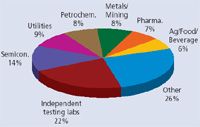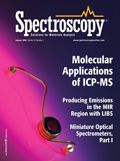Market Profile: ICP & ICP-MS
Inductively coupled plasma (ICP) spectroscopy is an important optical emission technique, with strong applications in environmental testing and related areas. The basic principle of ICP involves the introduction of a liquid sample into an argon plasma torch, which provides the excitation energy required to stimulate atomic emission in the sample. The geometry of the torch with respect to the optical components provides one source of control over the analysis. The axial mode, with the optics directed toward the plasma jet, provides better detection levels, although the radial (side-on) mode generally is less problematic.
Inductively coupled plasma (ICP) spectroscopy is an important optical emission technique, with strong applications in environmental testing and related areas. The basic principle of ICP involves the introduction of a liquid sample into an argon plasma torch, which provides the excitation energy required to stimulate atomic emission in the sample. The geometry of the torch with respect to the optical components provides one source of control over the analysis. The axial mode, with the optics directed toward the plasma jet, provides better detection levels, although the radial (side-on) mode generally is less problematic.

However, most of the differences among the various ICP spectrometers available on the market are on the detector side of the equation. Traditionally, photomultiplier tubes (PMTs) were used to detect the emitted light, but now solid-state detectors have supplanted them in the majority of instruments. Large linear or area detectors can analyze multiple spectral lines simultaneously, providing very rapid analysis that appeals to high-throughput laboratories. PMTs remain common in sequential ICP, in which the instrument scans through the spectral range of interest sequentially. Although slower, PMT instruments typically offer the advantage of greater sensitivity. For laboratories that perform very standard analyses of a few elements, there are also simultaneous PMT instruments that have a dedicated PMT for each spectral line of interest.
Generally speaking, ICP is much faster than atomic absorbance (AA), while providing comparable performance. Coupling an ICP torch system to a mass spectrometer (ICP-MS) provides the ultimate in detection, down to part-per-quadrillion levels.
The total market for ICP and ICP-MS instrumentation was about $580 million in 2006. Growth for these techniques is in the single-digit range, with ICP-MS growing more rapidly than ICP.
The foregoing data were extracted from SDi's market analysis and perspectives report entitled Global Assessment Report, 9th Edition: The Laboratory Life Science and Analytical Instrument Industry , September 2006. For more information, contact Michael Tice, VP of Consulting Services, Strategic Directions International, Inc., 6242 Westchester Parkway Suite 100, Los Angeles, CA 90045, (310) 641-4982, fax: (310) 641-8851, www.strategic-directions.com.

Inside the Laboratory – The Petrochronology Group at University of California, Santa Barbara
January 29th 2024In this edition of “Inside the Laboratory,” John Cottle, PhD, a professor of geology at the University of California, Santa Barbara, and a member of Spectroscopy’s Editorial Advisory Board, discusses his group’s most recent work using “laser ablation split steam” analysis to measure elemental concentrations and isotopic ratios in rocks and minerals.